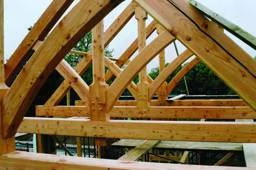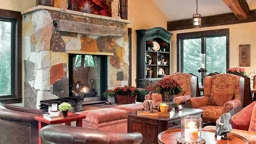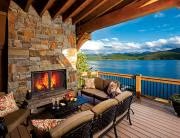
With simpler homes in vogue, how do you live cozy without being cramped? The answer isn’t square footage. It’s packing the livability you want into the space you have or can afford.
That means fewer rooms doing more. Just about every house has rooms or a room that gets next to no use. Sometimes it’s a bedroom, but often it’s the living room. And every house has rooms or corners of rooms that go overlooked.
Use them. Start by seeing your house not as rooms but as livable space. Rooms mean walls and halls—rigid, wasted space. “The idea that a house is composed of rooms for separate activities is fundamental to how it’s defined,” Sarah Susanka observes in The Not-So-Big House: A Blueprint for the Way We Really Live. “But a room is an artificial construct, an attempt to put boundaries around space. The idea of the room can be replaced with the notion of places for various activities.”
Timber homes rely on posts and beams to bear the house load, so partition walls can fit almost anywhere, sometimes nowhere. If you’re designing your home or planning a major overhaul, first apportion your space for a fluid layout, then position the walls. That way, your home will live your way, rather than you living your house’s way.
See also Anatomy of a Small (and Smart) Timber Frame Home
A few years ago, the notion of abandoning formal living rooms in favor of home offices might have seemed preposterous. Today, Americans want more or at least something different from their homes. The tendency, especially among timber-home owners, is toward greater informality. This attitude encourages ingenuity in putting form before function when it comes to planning and living in your timber home.
Aim for a floor plan that offers the most use from the space available. Rooms that do double, sometimes triple, duty are the most practical solution. Put it this way: Double-duty rooms give you twice as much house as you paid for.
Get the most from double-duty rooms by listing all the ways you hope to use your timber home. Then identify how many might share space, either at the same time or different times.
Here are some obvious and not-so-obvious combinations:
1. Spare bedrooms and home offices.
This has become a common accommodation to the telecommunications revolution, so the first thing people who work at home look for when designing their new home is a separate home office. Maybe, but what kind of work do you do at home, and how often do you need the spare bedroom? Two concepts: computer armoire and Murphy bed. In fact, freestanding open-ups can double the utility of any room.
Not all bedrooms are spare, but they all have some spare time, even master bedrooms. Think about it. You spend a third of your life sleeping, but what’s going on in your bedroom the other two-thirds of the time? Unless you sleep in shifts, either add more functions to the master suite or shrink it. Maybe move in workout equipment that fits under the bed when not in use, or rolls in and out of a closet.
2. Kitchens and computer workstations.
Kitchens aren’t so single-minded. You may already know them as the life of all your parties, but what about when you aren’t entertaining? Add a desktop counter and some shelves or drawers, and you have a spot to sit and pay your bills, check e-mail, research recipes, etc.—not a fully equipped home office, but it might meet your family’s computer needs without requiring a dedicated computer room. If yours is a family that enjoys togetherness, the kids can do their homework while you’re prepping and cooking.
See also 5 Ways to Create a Kitchen Office
3. Library and guestrooms.
Putting bookshelves where company can reach them might assure that some of the books you’re stockpiling actually get read. But with ingenuity, guestrooms can handle major storage and still be turned into hospitality space when company calls.
4. Mudrooms and laundry rooms.
Depend-ing on the degree of muddiness, you may even find it practical, because the plumbing is already there, to add a shower stall.
5. Stairs and closets.
A big chunk of your home’s available space is storage, specifically closets. Besides space beneath beds, look for storage under stairs. You can enclose the space for a closet, shelving units or a desk under open-tread stairs. Stairs by the front door are great for a coat closet and to establish a modest foyer before transitioning indoors.
Stairs all by themselves can significantly contribute to the look of your home and tie into the timbers to create a smooth transition between levels. Adding a landing and a turn can create a sort of sub-loft that accommodates a sitting bench, a small storage chest or a mini art gallery.
If you’re going whole hog with stairs, however, consider a full second story instead of the familiar half-story open to the great room below. You’ll get more bonus space, and your stairs will seem less confining.
See also 6 Big Ideas for Small Timber Homes
Combinations that rarely work out are kitchen-bathroom, garage-bedroom and home office-kitchen. Likelier candidates for double duty are lofts, spare rooms and big, open rooms that can be subdivided functionally.
Some other observations:
6. Basements invite multiple uses.
Don’t get so carried away with living space that you neglect storage. The more you can stash below, the less you’ll need room for above. Closets devour square footage.
See also Design Ideas for Built-Ins
7. Don’t overlook the outdoors.
Porches and decks are traditionally spots to sit and soak up the sun or relax in the shade, but lately they’ve moved in the direction of outdoor rooms. Some even have fireplaces. A patio off the kitchen can be an asset for summer entertaining and preclude having a formal interior entertainment space. If you want indoor entertaining space, use the basement.
8. Sunrooms or screened-in porches can host multiple activities.
Sunrooms are especially hospitable for sitting or informal dining in winter when the sun warms them naturally. Screened-in porches are productive workspaces in summer, whether for home offices or hobbies.
9. Lofts, either enclosed or open or both, offer versatility because they convert easily to just about any use.
Visiting grandkids love lofts for hideouts, especially sleeping lofts that have ladders or spiral staircases for access. But full-time residents welcome a lofty perch to escape, too. The trouble with lofts is that they take up space that in most houses would be attic. Not having an attic can help prevent you from accumulating stuff you really shouldn’t be keeping anyway, but some things are worth saving. Lofts, indeed all upper-level space, can add living room with dormers and storage space with knee walls—short perimeter walls that run from floor to the angle of the roof.
10. Bathrooms also offer more than the obvious.
All but the smallest can handle a dressing area. You see many floor plans where the master suite has separate walk-in closets and master baths. A variation is to connect bathroom and closet, assuring, of course, proper ventilation and lighting. This arrangement works even in small homes by reallocating space from another area of the house.
Here are some general tips to help when planning your spaces according to function:
11. Combine activities that don’t clash.
Light and noise are usually big sticking points. That’s why cocktail parties and bedrooms generally don’t mix. One way to deal with incompatibilities is to plan the house to transition from the noisiest group activities to the quietest, most solitary ones. Basically, waking and sleeping people should be far apart. Whichever space you deem to be your inner sanctum should have a door. It may be a bedroom that has room for a sitting area, perhaps a TV, maybe even a private balcony or patio. If you have this space, use it for activities such as enjoying morning coffee or even eating whole breakfasts there.
12. Avoid having an eat-in kitchen and an adjacent dining area.
Shrink the kitchen (look at how little actual working space some of those TV chefs use to get the job done), and eat all meals at the dining table. Get a table with leaves and room to add them all when company comes or to use as a buffet for guests loading up their plates to go sit on the porch and eat.
See also Maximizing Small Kitchens
13. Kids don’t need their own rooms.
Sharing space draws families closer. Even bathrooms.
14. Double-duty rooms aren’t just for small houses.
In fact, bigger homes have more room to play with. The mistake some people persist in making with big homes is compartmentalizing the square footage to create more rooms. Once you define a room, that’s what it is, and when no one needs that function, the room sits unused with the door closed. Wide-open space can readily accommodate multiple functions without rigid definition. Indeed, multiple functions are important to rein in vastness and provide cues as to function.
Use caution, though. Open space tends to become a catchall—not a desired result of double-duty living. Organization, visual groupings by function and closets can keep clutter under control.
15. Regardless of whether your home is big or small, an open great room can establish a main sitting area, a secondary area, and even a nook or two for quiet activity or just looking out the window.
Successful great rooms have focal points, which in timber homes are traditionally windows for a view and a fireplace for mood. These can be combined, leaving the loft as a second focal point, especially if the stairs and loft railings coordinate with the timbers.
16. In small houses, open space almost by necessity removes walls and halls, and lets areas visually borrow from adjacent space.
Some homeowners with great views orient their layout so that almost all the rooms enjoy the view. Taking advantage of such a feature adds a focal point to rooms that might otherwise lack one, influencing how these rooms function. Back rooms can take advantage of the light from front ones, allowing a spare bedroom to double, say, as a painting studio or reading room.
So share away. Just remember that every home needs private space. It doesn’t need to be exclusive, however. For instance, a physical fitness room can also accommodate spiritual meditation simply by placing a screen between the Bowflex machine and the zabuton cushion. Carve out personal space within larger areas by using alcoves and window seats. These built-ins amplify usefulness of larger spaces.
A final tip: Anticipate adding new uses to already-in-use space, especially if you have a growing family, or work at home and are on the verge of retiring. Any time your living situation changes, you have an opportunity to repurpose space rather than enshrine it.






_11868_2023-06-30_11-50-256x288.avif)



